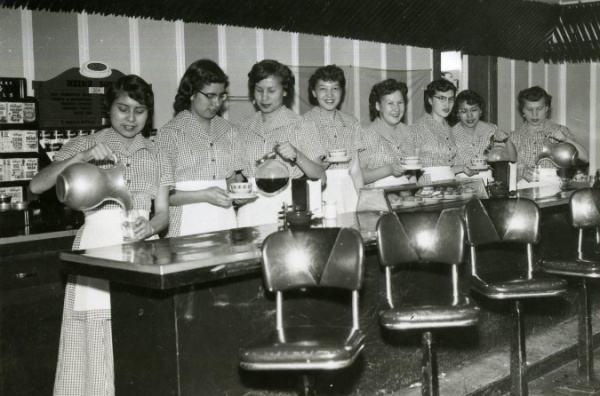South Dakota Tea Rooms
From Mystic Tea Room
(Difference between revisions)
(edit and save) |
(inserted city header) |
||
| Line 1: | Line 1: | ||
| + | South Dakota State Tea Room Gallery, in alphabetical order by name of city or town. | ||
| + | |||
| + | == Flandreau == | ||
| + | |||
[[File:Flandreau-Vocational-School-Tea-Room-Flandreau-Santee-Sioux-Agency-Fladreau-SD-1947-photograph-National-Archives.jpg|center|600px|thumb|The Flandreau Vocational School Tea Room, Flandreau Agency, Flandreau, South Dakota, 1947, photograph from the National Archives. Founded in 1873, the Flandreau Agency served primarily Santee, Sisseton, and Wahpeton Sioux Indian students. The Flandreau Santee are members of the Mdewakantonwan people, one of the sub-tribes of the Isanti (Santee) Dakota originally from central Minnesota. The Santee who established the colony at Flandreau were Christian Indians who homesteaded their lands pursuant to article VI of the Fort Laramie treaty of 1868, which provided that Natives could take homesteads and become United States citizens and still retain the benefits provided to them by the treaty. This photograph, titled "Tea Room" in the National Archives, appears to show a subsidized work-experience program for young women. Arrayed with bilateral symmetry. according to their tasks (pouring water, pouring coffee, holding tea cups and saucers), they are also seemingly prepared to offer breakfast-packs of Kellogg's Corn Flakes to their customers. Thanks to Erin Nichole Handy for locating this unusual tea room.]] | [[File:Flandreau-Vocational-School-Tea-Room-Flandreau-Santee-Sioux-Agency-Fladreau-SD-1947-photograph-National-Archives.jpg|center|600px|thumb|The Flandreau Vocational School Tea Room, Flandreau Agency, Flandreau, South Dakota, 1947, photograph from the National Archives. Founded in 1873, the Flandreau Agency served primarily Santee, Sisseton, and Wahpeton Sioux Indian students. The Flandreau Santee are members of the Mdewakantonwan people, one of the sub-tribes of the Isanti (Santee) Dakota originally from central Minnesota. The Santee who established the colony at Flandreau were Christian Indians who homesteaded their lands pursuant to article VI of the Fort Laramie treaty of 1868, which provided that Natives could take homesteads and become United States citizens and still retain the benefits provided to them by the treaty. This photograph, titled "Tea Room" in the National Archives, appears to show a subsidized work-experience program for young women. Arrayed with bilateral symmetry. according to their tasks (pouring water, pouring coffee, holding tea cups and saucers), they are also seemingly prepared to offer breakfast-packs of Kellogg's Corn Flakes to their customers. Thanks to Erin Nichole Handy for locating this unusual tea room.]] | ||
Revision as of 04:14, 30 October 2020
South Dakota State Tea Room Gallery, in alphabetical order by name of city or town.
Flandreau

The Flandreau Vocational School Tea Room, Flandreau Agency, Flandreau, South Dakota, 1947, photograph from the National Archives. Founded in 1873, the Flandreau Agency served primarily Santee, Sisseton, and Wahpeton Sioux Indian students. The Flandreau Santee are members of the Mdewakantonwan people, one of the sub-tribes of the Isanti (Santee) Dakota originally from central Minnesota. The Santee who established the colony at Flandreau were Christian Indians who homesteaded their lands pursuant to article VI of the Fort Laramie treaty of 1868, which provided that Natives could take homesteads and become United States citizens and still retain the benefits provided to them by the treaty. This photograph, titled "Tea Room" in the National Archives, appears to show a subsidized work-experience program for young women. Arrayed with bilateral symmetry. according to their tasks (pouring water, pouring coffee, holding tea cups and saucers), they are also seemingly prepared to offer breakfast-packs of Kellogg's Corn Flakes to their customers. Thanks to Erin Nichole Handy for locating this unusual tea room.




